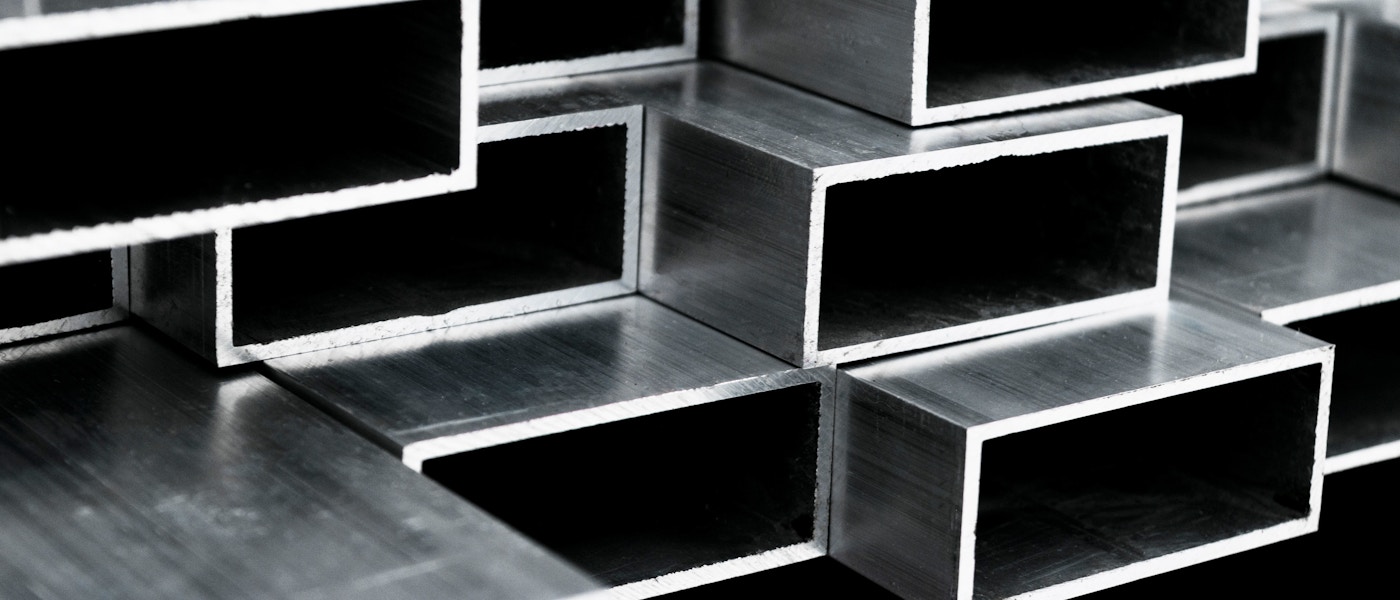What sizes do we supply?
Our bespoke aluminium profiles can be formed to almost all specifications, so please call us to discuss your own requirements.
Who do we supply?
Below is a thorough, but not exhaustive list of some of the industries we can cater to:
Defence
Transport
Marine
Building
Architectural
Petrochemical
Leisure
Nuclear
Automotive
Aerospace
Electrical
Rail
Medical
Engineering
Signage
Lighting fixtures
Why Aluminium Box Section?
Aluminium box sections are often sourced from 6000 or 7000 series grade metals, these grades have the dual qualities of offering excellent corrosion resistance and being heat-treatable.
For other bespoke requirements such as specific aerospace applications, there are also many other grades, especially those in the 2000 series, that can be substituted.
Versatility
The versatility of aluminium is well documented and its numerous uses include widespread use in the key industries of aerospace, automotive and all sectors of the marine industry, among many others such as building and architecture.
Aluminium is also one of the more malleable metals and in many cases can even be a suitable substitute for plastic when a project calls for more intricate precision.
This ease of fabrication is the jewel in the aluminium crown as it crosses the boundary between plastics and metals and can perform (with some limits) the requirements of both materials.
Aluminium as a base metal contains no iron which means it does not magnetise like other metals, it is also lightweight, with high tensile strength and corrosion resistant to a significant level.
This, coupled with its better-forming properties make it the preferred ‘non-ferrous’ option to stainless steel for many projects.
Its eye-catching nature is also highly prized giving a bright and vibrant colour and shine that draws the eye.
As well as exemplary performance and standout look, it is also one of the most recyclable materials on earth making it a cost-effective and energy-aware choice.
As a box section option, aluminium does have some standout qualities when compared to steel or indeed, plastic.
These include:
It is very strong
Non-magnetic
Superb surface finish
Corrosion resistant
Easy to weld, shape and fabricate
Lightweight
Will not rust when used outdoors
Versatility
Adaptability
Aluminium Box Sections can be drilled, cut, machined and fabricated and they are also an ideal material for polishing, powder coating and anodising.
This allows designers a free reign on creativity while keeping within bespoke specifications, it truly is a metal of extreme importance as consumer requirements become more intricate and customer demands more exacting.
Common grades of aluminium used for box sections
Aluminium alloy 6061
Comprised at its base alloying level of magnesium and silicon aluminium 6061 is historically one of the more commonly used grades.
Known as one of the more ‘multiple use’ grades its many diverse possibilities can be found across multiple trades and industries.
This chemical structure creates dependable characteristics such as tensile strength, weldability and corrosion resistance, and as such, this metal lends extremely well to trades where structural support is vital such as building and architecture.
In building for example it may be used for:
Roofing
Heating and cooling systems
Curtain walls
Siding
Stairways
Renovations of historic buildings
It is also used in the base construction of yachts and small utility boats, as well as bicycle parts and frames.
Aluminium alloy 6082
A medium-strength alloy with superb corrosion resistance properties, it boasts the highest strength level of all 6000 series alloys and is one of the ‘structural alloys’.
When utilised in plate form, 6082 is most preferred as a machining alloy and indeed has come to replace its predecessor (6061) in many of today’s applications.
This is due in large part to its even greater tensile strength which is created by a greater concentration of manganese.
It is, however, tricky to produce intricate thin-walled shapes in 6082, this is because once extruded the finish isn't as smooth as some of its other 6000 series counterparts.
In both the T6 and T651 tempers, 6082 performs well as a machining option and is a good candidate for welding though this does lower its strength performance.
Aluminium alloy 6063
Also alloyed principally with silicon and magnesium, 6063 mixes in small amounts of manganese, chromium, iron, zinc, titanium and copper, creating a medium-strength alloy with high corrosion resistance and a great surface finish. Often referred to as an architectural alloy, 6063 is more suited to complicated and difficult extrusions and is commonly preferred in the T6 temper grade.
These common box section alloys are perfect for their roles and highly adaptable to many purposes.
We also supply and source many other box section grades and tempers for more niche projects and applications. Please see our website or contact us for a full list of our materials and their uses.
How to make aluminium box sections
Aluminium tubing has been in commercial use since the 1840s and its importance in many forms of industry has become more and more pronounced, but how do we make square tubes, or box sections?
Aluminium manufacture begins with a simple lump of metal called a slug or blank.
This is fed into a shaped narrowing tool known as a die, this process of forming the initial metal shape is known as extrusion and can be used to form a rough completed tube.
Next, we cut the tubing to the correct length as specified, the tube is then threaded and a ‘cap’ is screwed on.
During the extrusion process, aluminium becomes work-hardened, meaning simply that it becomes harder.
After hardening, a process of metallic bonding ensures a metal's malleability.
What is metallic bonding?
Once the metal is heated to around 460°c, electrons within the metal become less solidified and move freely within the grain structure's nuclei, this allows the nuclei to adjust within the metal but the bonds don’t break, allowing shaping and malleability.
If required, an internal lining will then be sprayed into the metal, this process is often used in pharmaceutical applications to act as a protective barrier between metal and packaging.
The metal is then prepared for use in many different industries and projects, and due to aluminium's unique composition and performance characteristics, the design options are almost limitless.
Creating the Box Section: How to bend aluminium
Aluminium Rolling
The next step to making a box section is bending the aluminium, firstly we will look at the rolling method.
Rolling is a pivotal technique whereby the metal is conveyed along three adjustable rolls, which gradually mould the desired design shape.
This ‘rolling’ process significantly enhances the strength yield properties of the metal.
Rolling is an ideal addition to the forming processes of larger profiles with various radii and intricate cross-section pieces. It is certainly the most cost-effective and indeed flexible of all bending methods, with complex profiles being easily achievable with tools already to hand.
For most industrial projects, two-dimensional bending is enough, but with aluminium rolling a third dimension can also be added such as any required twists in the profile.
This type of section bending often has a bespoke role in industry and as such is usually found in very specific usage such as:
Office and interior
Architecture
Curtain walling
Aerospace
Marine applications
Vehicle parts
Aluminium Rolling has changed the face of industry as we know it, its use propagating throughout the commercial world from enormous aerospace projects to the foil on chocolate bars, wherever you look, you will see it being used.
Mandrel Bending
Rolling, though extremely prevalent, does have its disadvantages such as when trying to roll a thin-walled profile in a small radius. This action increases the tensile burden and therefore creates a greater risk of straining or sundering. In this situation, Mandrel Bending may be the better option.
Mandrel bending offers a very specific skill set, namely to create the tightest bends while still holding significant strength characteristics in the metal.
Ideal for either round or square pipe construction, mandrel bending is a technique whereby a steel rod is placed into the given tube as it undergoes the bending process.
This method allows for the tube to bend without it breaking or losing surface internal integrity at the bending point.
How does it work in practice?
Well, let's take the example of a straw, if you bend the straw, the bend point becomes highly constricted and would present a high blockage risk for any matter flowing through it such as petrol in the case of vehicle applications.
The Mandrel bending technique keeps the same dimensions throughout the bend, while also keeping the material solid under duress.
Mandrel bending is done using a CNC tube bender, a tool ideally built for shaping thin tubing without deformation in the required tight radius.
It takes little imagination to see that the applications for mandrel bending are many and varied and can be applied to all forms of tubing and across multiple industries.
Stretch bending
Stretch bending began within the aviation industry and is an intricate processing method that has seen many advancements over the years.
It is now widely used within architecture, machinery parts and the automotive industry to name a few.
The technique is pivotal to parts manufacture especially and has revolutionised this area of industry, so what is stretch bending?
This technique as the name suggests involves metal stretched to create perfectly shaped parts.
To do this, a specific machine called a stretch press pulls the metal to a pre-specified stretch point, this known threshold allows the metal to be shaped in very specific ways while holding its chemical composition and surface integrity.
The stretch press is basically a two-ended ‘vice’ that clamps the profile at either end, creates tension and then pulls or ‘stretches’ the metal around a bespoke mould.
This makes it an ideal profiling method for tenting, facades and aerofoils, and other applications where the cosmetic value is of principal importance.
Advantages of stretch bending.
Enhanced efficiency: The stretch bending process creates minimal potential problems as the machine reliably does the work.
Reduced man hours
Reduced tool costs: Other methods often require multiple tools.
Less industrial waste: Due to the precision of stretch bending, there is less unused excess material.
Stretch bending allows for the creation of parts that were only dreamed of before, thus creating applications that further the possibilities of industry.
How to connect aluminium box sections to each other
Once the box sections are made, a method of connecting them is needed.
There are a few methods of doing this, one of which is by welding using Tungsten Inert Gas, or TIG welding as you may know it, but the much more popular method is by using tubing connectors.
These connectors ‘plug’ tightly into either end of the tube and form a link between one section and another, creating a strong framework.
This is of course absolutely ideal for projects requiring frequent assembly and take down such as stands, shelving and large tenting.
The connectors themselves are constructed from durable nylon and can be counted on to sustain substantial pressures and the harshest of natural environments.
Connecting box sections using aluminium tubes
Cut the box sections to the required length using a hacksaw or chop saw, being absolutely sure that the tubing is tightly clamped. It is also vital to take into account the width of the solid section of the intended connector when cutting.
Using a metal finishing pad or emery cloth, remove any sharp edging.
Attach the connector into the tubing by hand initially, ensuring to grip the box section tightly. Keep using your hands to push until the connector feels well seated.
Hammer the connector until snug, do this using only a rubber mallet to ensure no damage to either the connector or the box section.
Repeat the process for all the sections you wish to connect.
Summary:
As these techniques continue to shape our world, so the expanse and ideology of aluminium production will continue to grow.
It becomes an ever more valuable resource due to its countless alloying possibilities. This unrivalled practicality within the metals market suggests a fantastic future for this most bountiful of earth’s natural metals.
A bit about us
At Righton Blackburns, we pride ourselves on being an industry leader in the supply of metals and plastics for any and all projects and businesses.
Many of the specifications for other materials can be found on our other pages and posts and we are able to source pretty much anything you may need.
Our expert team is on hand to help you through each part of the process from selecting the right materials and tools and helping you each step of the way through to the end of your project.
We back our hand-picked team to deliver at every stage of the process with experience, substantial collective knowledge and diligent application to every task.
If you have any questions or queries about this post or any other industry-specific topics, please feel free to call our team today and we will assist in any way we can.




